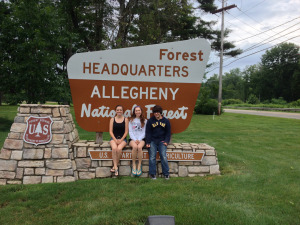In July 2014, the Bureau for Historic Preservation received an American Battlefield Protection Program planning grant from the National Park Service to locate, document, and delineate the boundaries of a significant, but little known Revolutionary War conflict site in northwestern Pennsylvania. The Battle of Thompson’s Island, in present day Warren County, is listed with “Other Sites of Interest” in the 2007 Report to Congress on the Historic Preservation of Revolutionary War and War of 1812 Sites in the United States, but its exact location is unknown. In fact, it is possible that the battle simply took place near Thompsons Island, not on it—but we are certain that it is located within the Allegheny National Forest. This project seeks to answer some of those questions.
War on the Pennsylvania Frontier
As we all know, the American Revolution was a war between soldiers of the British Empire and soldiers, both regular (Continentals) and militia, of the 13 American colonies. A lesser known aspect of the war was that it included raids on Colonial frontier settlements by British forces, along with Tory forces loyal to the British Crown and their Native American allies, including members of the Iroquois Confederation. These raids reached a fever pitch in 1778. Probably the best known of these raids in Pennsylvania was the Battle of Wyoming, also known as the “Wyoming Massacre,” which took place on July 3, 1778. During the battle, a force of about 400 militiamen took on a force of British Regulars, Tories, and Native Americans. Of the 400 militiamen who took part in the battle, only 60 would survive; 227 would be scalped by the Native Americans.
Generalized map showing Sullivan’s, Clinton’s, and Brodhead’s campaign against the Iroquois from Trussell, John B., Jr., “The Sullivan and Brodhead Expeditions,” ed. Harold L. Myers. Historic Pennsylvania Leaflet No. 41. Harrisburg, PA: Pennsylvania Historical and Museum Commission, 1976.
As a result of raids like the Wyoming Massacre, General George Washington, in 1779, began a campaign against the Native American allies of the British, particularly the Iroquois Confederation. As part of this campaign, Major General John Sullivan, along with eleven regiments—regimental manpower varied, but a regiment generally included hundreds of soldiers—of Continentals (over 2,300 men total), would march approximately 70 miles northwest from Easton, Pennsylvania, to Wyoming, Pennsylvania. From there, the troops would march another approximately 70 miles northwest to what was then known as Tioga Point, Pennsylvania; it is now known as Athens, Pennsylvania. At the same time, Brigadier General James Clinton would lead five regiments of Continentals down the North Branch of the Susquehanna River to meet up with Sullivan. After the two groups met up they would proceed west to the Finger Lakes of New York, striking at the Iroquois by destroying everything in their path. They would continue to Genesee, an Iroquois town.
Artist’s rendering of Colonel Daniel Brodhead from Trussell, John B., Jr., “The Sullivan and Brodhead Expeditions,” ed. Harold L. Myers. Historic Pennsylvania Leaflet No. 41. Harrisburg, PA: Pennsylvania Historical and Museum Commission, 1976.
As Sullivan was moving north on the eastern side of Pennsylvania, Colonel Daniel Brodhead would lead the 8th Pennsylvania regiment north from Fort Pitt (modern-day Pittsburgh)—Fort Pitt had been decommissioned by the British in 1772 and, during the Revolutionary War, it served as the Western headquarters of the Continental Army— destroying everything in their path. If feasible, they would meet up with Sullivan in New York and either move on against Fort Niagara or turn back. On August 11, 1779, Brodhead and his men left from Fort Pitt and headed north, mostly following the Allegheny River. Around August 18, an advance guard of Brodhead’s men came upon 30 to 40 Allegany Seneca (members of the Iroquois Confederation) and a battle ensued, resulting in 3 American wounded and 5 Seneca killed; the rest retreated. The battle was the only Revolutionary War battle in northwestern Pennsylvania and is popularly referred to as the Battle of Thompson’s Island. After the battle, Brodhead continued north, burning Native American villages. After this, Brodhead’s men returned to Fort Pitt, arriving there on September 14. The campaign lessened the raids, but they would continue throughout the Revolution.
The Search Begins
With input from stakeholders including the Allegheny National Forest, the Seneca Nation of Indians, and the Friends of the Allegheny Wilderness, we have prepared a Scope of Work to be sent out to several Cultural Resource Management companies for bid. When the project is completed, we hope to have a detailed history, including GIS mapping, of Brodhead’s campaign from start to finish, a detailed history, including GIS mapping, of the Battle of Thompson’s Island, and archaeological survey to both locate and delineate the boundaries of the battlefield. We will keep you posted as the project moves forward, so stay tuned!
Comment Policy
PHMC welcomes and encourages topic-related comments on this blog. PHMC reserves the right to remove comments that in PHMC’s discretion do not follow participation guidelines.
Commenters and Comments shall be related to the blog post topic and respectful of others who use this site.
Commenters and Comments shall not: use language that is offensive, inflammatory or provocative (this includes, but is not limited to, using profanity, obscene, or vulgar comments); disparage other commenters or people; condone illegal activity; identify the location of known or suspected archeological sites; post personal information in comments such as addresses, phone numbers, e-mail addresses or other contact details, which may relate to you or other individuals; impersonate or falsely claim to represent a person or an organization; make any commercial endorsement or promotion of any product, service or publication.
If you would like to comment on other topics not related to this blog post but related to PHMC, please fill out the PHMC Contact Us Form.
